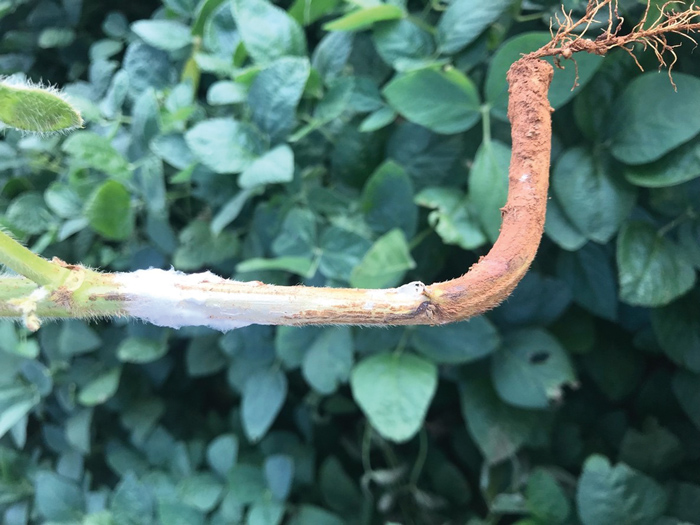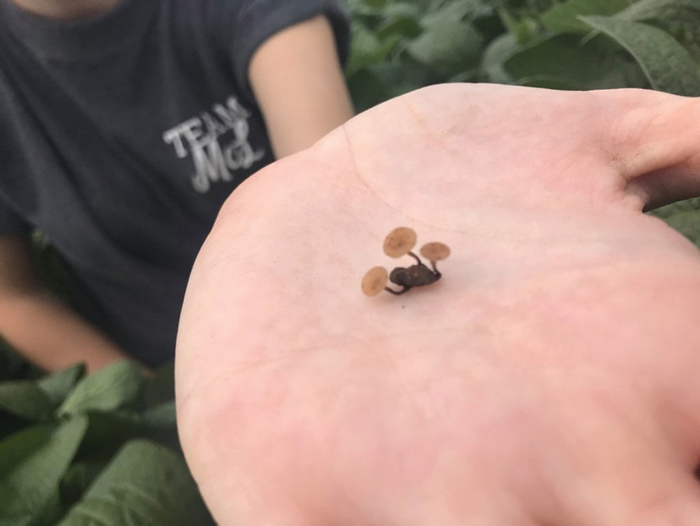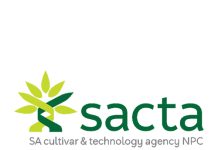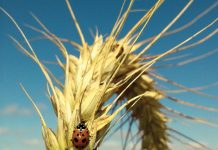The first report of Sclerotinia in South Africa was on apricots in 1953. Thereafter, the disease was reported on soybeans in Lydenburg (1979) and sunflower (1980) in localised regions of Gauteng, Limpopo, Mpumalanga, North West, KwaZulu-Natal and the Free State.
Since then, Sclerotinia diseases occur throughout the country on a variety of plants, including oilseeds (such as soybeans, sunflower and canola), vegetables (for example cabbage) and weeds. In South Africa, Sclerotinia research has received significant attention since the mid-2000s due to the occurrence of severe epidemics on especially soybeans and sunflower.
In 2017, researchers from the University of the Free State (UFS) established the South African Sclerotinia Research Network (SASRN), with the aim to increase collaboration between researchers involved with or experienced in Sclerotinia diseases. Grain SA recognised that collaboration was key to addressing on-farm challenges posed by this devastating disease and an industry-academia partnership was established. Since then, Grain SA and UFS have collaborated to bring cohesion to the Sclerotinia research space.
In the next few editions of SA Graan/Grain, articles featuring current research on Sclerotinia will appear, including evaluating cultivars for tolerance against this disease and the population genetics of S. sclerotiorum. In this first article, an overview of research conducted to date will be presented. Past Sclerotinia research in South Africa has mainly focussed on cultivar evaluations, testing of chemical and biological control as well as agronomic practices.
Cultivar evaluations
It is widely known that there are no cultivars with complete resistance to Sclerotinia diseases. Tolerance (which describes partial resistance and can vary from relatively little resistance to almost resistant) is used in cases where complete resistance is lacking. Locally, tolerance to Sclerotinia diseases is usually moderate or mild.
Researchers from UFS, the Agricultural Research Council (ARC), the University of Pretoria (UP) and the University of KwaZulu-Natal (UKZN) have tested the tolerance/susceptibility of soybean and sunflower cultivars to Sclerotinia sclerotiorum. Reproducibility of results as well as ranking of cultivars have proven to be an immense challenge and prohibited clear recommendations to be made available to producers. The sporadic nature of the disease is a further obstacle that is hard to overcome. Cultivar evaluations need consistent infections in field over multiple years to enable statistical analyses to be significant (or trustworthy).
An additional challenge which was overcome in the past few years has been the development of a robust inoculation method for in-field trials. The ideal method should mimic natural infection, prevent ‘over-inoculating’, while at the same time ensuring sufficient inoculum is present to ensure even exposure and uniform infection across the field. Without a robust inoculation method, screening for tolerance/susceptibility cannot be effectively achieved.
Poor correlations between greenhouse experiments and field trials pose a significant challenge to research. Greenhouse experiments are cheap to execute, easy to control and can be easily repeated. These experiments are frequently used in the research community to determine tolerance or resistance to diseases such as grey leaf spot and northern corn leaf blight. However, in the case of Sclerotinia, field trials are still the best method for tolerance screening.
An additional challenge is that it appears that cultivars respond differently depending on the levels of inoculum present in the field. Three reaction types have been proposed (but not thoroughly researched to date): i) high susceptibility under low disease potential; ii) tolerance up to a certain disease potential; and iii) tolerance despite increasing disease potential (Sclerotinia WG, June 2006). Cultivars also respond differently to changing environmental conditions (Steyn, 2015).
Molecular studies have been conducted to identify potential sources of resistance (Mbedzi et al., 2019). Tolerance to the disease is made up of numerous genes across the plant genome. Therefore, molecular studies focus on:
- which genes are related to tolerance;
- which genes or gene combinations are more or less important for the plant to have; and
- which of these genes or gene combinations are present in different lines or cultivars.
A similar study is being conducted by Dr Minnaar-Ontong at the UFS in this regard.
Important to note is that artificial inoculations do not allow for disease escape, which occurs when plants complete flowering before inoculum is present in the field. Short growers planted early in the season can often escape disease. In artificially inoculated cultivar evaluations, short growers planted early in the season can be deemed very susceptible, when in fact these allow for disease escape.
Chemical and biological control
Trials to assess chemical and biological control methods have been conducted by chemical companies as well as research institutes. The major challenge with these trials were the lack of a robust field screening method to obtain Sclerotinia infection in subsequent years. Previous trials often failed due to absent or low Sclerotinia infection, and the inability to test the reliability of results using statistics.
Chemical control
Timing and application of chemical control is important. Chemical control can be applied proactively when apothecia are present in the field alongside hosts which are at susceptible stages (for example soybean at flowering stage). Apothecia are small mushroom-like structures which release spores and are formed when sclerotia germinate. Producers are encouraged to scout for apothecia. Application of fungicides over very dense canopies prevent the fungicide from reaching the stem where the fungus is growing inside the plant.
For more information click on the QR code.
Biological control
The potential of using strains of Trichoderma harzianum, a fungus frequently used in biofungicides to suppress soilborne diseases, has been investigated in South Africa. The fungus forms symbiotic relationships with plant roots and parasitises other fungal pathogens. T. harzianum has been shown to be effective in reducing soilborne diseases like Fusarium stalk rot, and increased the maize rhizosphere microbial community. In addition, intense field and glasshouse studies have been conducted on the fungus Coniothyrium minitans which is commercially available as Contans®. For more information click on the QR code.
It is important to note that the biocontrol activity of T. harzianum is strain specific. In South Africa, two T. harzianum-based biocontrol products have been screened for antagonistic activity toward S. sclerotiorum; Eco77® and EcoT®. The products were tested on sunflower and soybean in vivo and under glasshouse conditions (Sclerotinia WG, 2005; Mathews et al., 2019; Elungi, 2009). In vitro antagonism of EcoT against S. sclerotiorum on soybean seed revealed that the products did not affect germination and that fewer seedlings developed disease when treated. Application of Eco77 to plants reduced disease incidence. Silicon treatments were included with Eco77, but no significant contribution to disease prevention was observed (Mathews et al., 2019).
Agronomic research
It is widely accepted that the microclimate resulting from canopy closure in soybeans plays a big role in disease development. Canopy closure limits airflow between plants, which creates conditions beneficial to disease development. It also makes the application of chemical control agents incredibly difficult as the canopy prevents penetration of the control agent by the stem. To prevent canopy closure, wider rows can be planted.
Planting dates and maturity groups can also be used to escape disease. Research has shown that planting early maturity groups (MG 4-4,5) during the normal planting period (between middle October to end November) results in completion of flowering and pod formation by the time environmental conditions are conducive for germination of sclerotia. Disease is then escaped, as the fungus exploits natural openings at flowering to enter the plant.
Click on the QR code for more information. 
The way forward
In future, research should focus on how the disease can be avoided and should enable producers to proactively address Sclerotinia diseases. Coordinated in-field cultivar evaluations in a variety of locations over multiple years are needed to clarify the susceptibility/tolerance levels of local cultivars. Reducing the incidence of Sclerotinia in seed and decreasing the longevity of sclerotia in soil will be massive steps towards reducing disease incidence.

Photo: Dr Lisa Rothmann

Photo: Dr Lisa Rothmann
Resources
- Elungi, K. 2009. Studies of integrated control of selected root diseases of sunflowers using Trichoderma harzianum (Eco-T®) and silicon. MSc dissertation, University of KwaZulu-Natal. http://ukzn-dspace.ukzn.ac.za/handle/10413/592
- Mathews, JR, Sivparsad, BJ & Laing, MD. 2019. Greenhouse evaluation of Trichoderma harzianum for the control of Sclerotinia wilt (Sclerotinia sclerotiorum) of sunflower. South African Journal of Plant and Soil, 36:1, 69-72, DOI: 10.1080/02571862.2018.1484189
- Mbedzi, PP, Van der Hoven, L, Vorster, BJ & Van der Waals, JE. 2019. Screening for Sclerotinia sclerotiorum resistance using detached leaf assays and simple sequence repeat markers in soybean cultivars. Crop Protection, 125, 104909. https://doi.org/10.1016/j.cropro.2019.104909
- Minutes of the Sclerotinia working group of the Protein Research Foundation. June 2005. https://www.proteinresearch.net/index.php?page=27-september-2005
- Minutes of the Sclerotinia working group of the Protein Research Foundation. June 2006. https://www.proteinresearch.net/index.php?page=28-junie-2006
- Steyn, C. 2015. Soybean response to rust and Sclerotinia stem rot under different biotic and abiotic conditions. PhD thesis, University of the Free State. https://scholar.ufs.ac.za/bitstream/handle/11660/2321/SteynC.pdf?sequence=1&isAllowed=y<

















